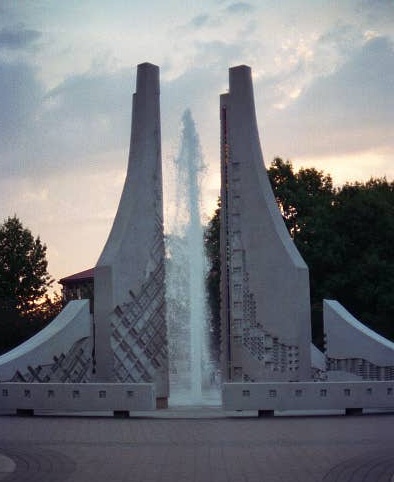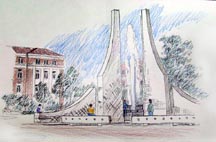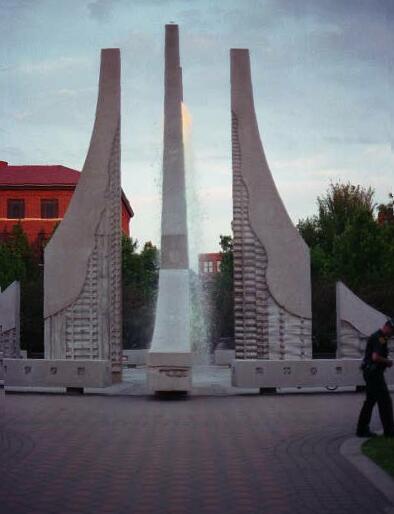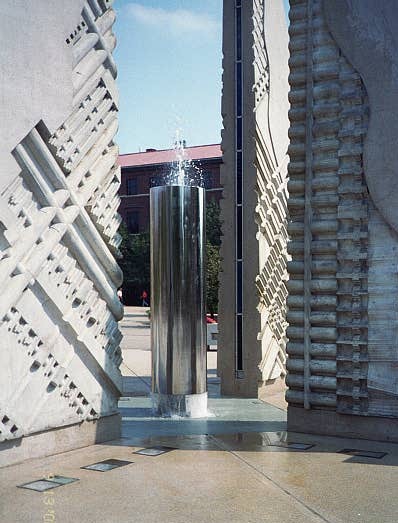

In the beginning:
|
 |
|
Enter the bureaucratsIn April 2001, students noticed that the fountain was still off, which was unusual after the spring thaw had completed Soon, an article appeared in the Purdue Exponent announcing that administration had decided to place fences around both the Engineering fountain and the Loeb fountain for safety reasons. They expressed concern that unsupervised "small children" were getting hurt on the concrete after being knocked over by the high-pressure water. What responsible parent would leave their child unsupervised on a campus of 35,000 undergraduates is beyond me, but that was the reason given. The nanny-state had come to Purdue; apparently common sense and signs indicating "fountain water under high pressure" were not enough to protect the community from itself. Rumor has it someone threatened to sue the university, and the bean counters were quick to react.Complaints were rampant, especially from students and the community; many locals apparently enjoyed letting their children play in the fountain under reasonable parental supervision. In an interview with the Exponent Executive Vice-President and Treasurer Ken Burns tried to take the blame himself and redirect it away from Purdue President Martin Jischke and University Architect Thomas Schmenk, the probable instigators of the new nanny-state program. This incident occurred near the end of Jishke's first year on the job; and the negative PR had to be terrifying those in charge of alumni donations. Finally, a committee was formed with the supposed goal of collecting community input on the situation. The best news for Purdue was that this delayed discussion and action until after the end of the semester when thousands of angry students wouldn't be there to complain. |
 (Artist's drawing of proposed fountain
fence; from Purdue University News Service)
|
|
Fountain police stateMeanwhile, the fountain was off. It was too embarassing to allow commencement and other important events to occur with a lifeless fountain at the center of campus, so the nanny-state came up with a solution--fountain monitors. The fountain was turned on for special events, but a Purdue staff member stood by with a two-way radio, ready to have the fountain turned-off at a moment's notice if anyone (small child, student, or otherwise) was having too much fun in the fountain. Private individuals could even have the fountain turned on for weddings and special events for $20/hour.At commencement in May 2001, the fountain was on but under apparent police protection. In the picture at right, notice the officer on patrol in the lower right hand corner. When the police weren't present that evening, the fountain monitors stood ready to shut off the water at a moment's notice. Several times over the summer I saw the fountain monitors shut off the fountain--once apparently only because the person playing around the fountain let out a shrill scream, similar to what you hear if someone jumps into a cold pool. While nobody was lookingWith students gone over the summer and no high-profile events for potential-donors, the fountain committee settled on a giant nine-foot cylinder as a solution to the safety "threat" posed by the fountain. The university wanted to have the cylinder in place before the first home football game so that the fountain could be on without being under guard (and so that alums wouldn't see the transition occur during the football season.)So, on September 13, 2001, while the rest of the nation was distracted by national tragedy (and therefore unlikely to notice the change, let alone publish a front-page newspaper article), Purdue erected a metallic cylinder in the center of the engineering fountain. |
 |
|
The Jischke/Schmenk Cylinder Arrives
|
 |
Inside Purdue article on university approval of the cylinder and limbo status of the Loeb fountain.
Inside Purdue article on installation of cylinder, with photos.
Retired University Architect Thomas Schmenk poses with Fountain Cylinder for an article on his retirement.
Physical
Facilities presentation slides from Fall 2001 regarding fountain
safety. (Internet Explorer only, unfortunately). Notice in the slides:
1) The unsafe climbing activities shown in slides 11-13 and used to
justify the changes are completely unaffected by either fences or the
cylinder. 2) They mistakenly say Purdue only has two fountains. (If they
ever find the others, will they put fences around them too?) The slides
were from the 2001 Midwest College/University Environmental Safety and Big
Ten Radiation Safety Officers Conference and were presented two days
before the Jischke/Schmenk Cylinder was erected.